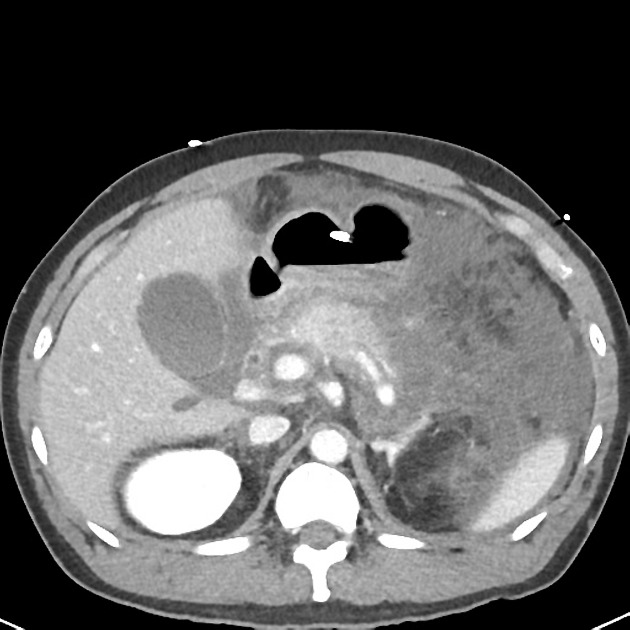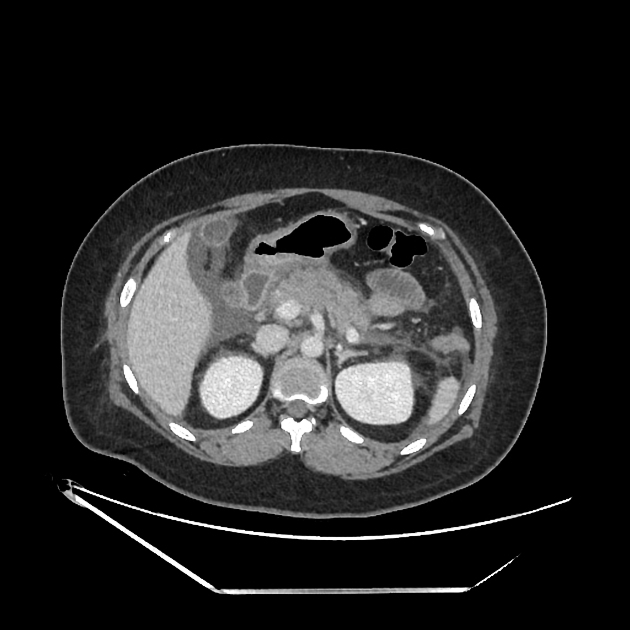Modified CT severity index (pancreatitis)
Citation, DOI, disclosures and article data
At the time the article was created Aditya Shetty had no recorded disclosures.
View Aditya Shetty's current disclosuresAt the time the article was last revised Mohammad Salem Amer had no financial relationships to ineligible companies to disclose.
View Mohammad Salem Amer's current disclosuresThe modified CT severity index is an extension of the original CT severity index (CTSI) which was developed by Balthazar and colleagues in 1990 for distinguishing mild, moderate and severe forms of acute pancreatitis.
The original CT severity index has been followed internationally and has been very useful. However, it has a number of limitations:
- it has been found that complications like organ failure, do not correlate well with the score given by original CTSI
- interobserver variability with original CTSI can result in different scores for the same patient
- it has been observed that patients with >30% necrosis have similar morbidity and mortality, thus including an additional 50% in the score was not practically useful
These limitations have resulted in the creation of the modified CTSI which correlates more closely with patient outcome in terms of duration of hospital stay and development of organ failure.
Modified CTSI
Scores are generated by estimating pancreatic inflammation and necrosis to give a score out of 10.
Pancreatic inflammation
- 0: normal pancreas
- 2: intrinsic pancreatic abnormalities with or without inflammatory changes in peripancreatic fat
- 4: pancreatic or peripancreatic fluid collection or peripancreatic fat necrosis
Pancreatic necrosis
- 0: none
- 2: 30% or less
- 4: more than 30%
Extrapancreatic complications
- 2: one or more of pleural effusion, ascites, vascular complications, parenchymal complications and/or gastrointestinal involvement
Total score
Total points are given out of 10 to determine the grade of pancreatitis and aid treatment:
- 0-2: mild
- 4-6: moderate
- 8-10: severe
References
- 1. Mortele KJ, Wiesner W, Intriere L et-al. A modified CT severity index for evaluating acute pancreatitis: improved correlation with patient outcome. AJR Am J Roentgenol. 2004;183 (5): 1261-5. doi:10.2214/ajr.183.5.1831261 - Pubmed citation
- 2. Jáuregui-Arrieta LK, Alvarez-López F, Cobián-Machuca H et-al. Effectiveness of the modify tomographic severity index in patients with severe acute pancreatitis. Rev Gastroenterol Mex. 2014;73 (3): 144-8. Pubmed citation
- 3. Bollen TL, Singh VK, Maurer R et-al. Comparative evaluation of the modified CT severity index and CT severity index in assessing severity of acute pancreatitis. AJR Am J Roentgenol. 2011;197 (2): 386-92. doi:10.2214/AJR.09.4025 - Pubmed citation
Incoming Links
Related articles: Pathology: Hepato-Pancreato-Biliary
- liver
- depositional disorders
- infection and inflammation
- liver abscess
- hepatic hydatid infection
- cirrhosis
- hepatitis
- cholecystitis
- cholangitis
- malignancy
- liver and intrahepatic bile duct tumours
- benign epithelial tumours
- hepatocellular hyperplasia
- hepatocellular adenoma
- hepatic/biliary cysts
- benign nonepithelial tumours
- primary malignant epithelial tumours
- hepatocellular carcinoma
- hepatocellular carcinoma variants
-
cholangiocarcinoma
- intra-hepatic
- mass-forming type
- periductal infiltrating type - Klatskin tumours
- intraductal growing type
- extra-hepatic/large duct type
- intra-hepatic
- biliary cystadenocarcinoma
- combined hepatocellular and cholangiocarcinoma
- hepatoblastoma
- undifferentiated carcinoma
- primary malignant nonepithelial tumours
- haematopoietic and lymphoid tumours
- primary hepatic lymphoma
- hepatic myeloid sarcoma (hepatic chloroma)
- secondary tumours
- miscellaneous
- adrenal rest tumours
- hepatic carcinosarcoma
- hepatic fibroma
- hepatic haemangioma
- hepatic Kaposi sarcoma
- hepatic lipoma
- hepatic mesenchymal hamartoma
- hepatic myxoma
- hepatic rhabdoid tumour
- hepatic solitary fibrous tumour
- hepatic teratoma
- hepatic yolk sac tumour
- inflammatory myofibroblastic tumour (inflammatory pseudotumour)
- nodular regenerative hyperplasia
- pancreatic rest tumours
- primary hepatic carcinoid
- benign epithelial tumours
- liver and intrahepatic bile duct tumours
- metabolic
- trauma
-
vascular and perfusion disorders
- portal vein related
- hepatic artery related
- hepatic veins related
- inferior vena cava related
- other
- third inflow
- liver thrombotic angiitis
- infra diaphragmatic total anomalous pulmonary venous return (TAPVR)
- hereditary haemorrhagic telangiectasia (Osler-Weber-Rendu disease)
- pancreas
-
pancreatic neoplasms
- cystic neoplasm (cystic pancreatic mass differential diagnosis)
- solid neoplasm
- non-epithelial pancreatic neoplasms
- others
- simple pancreatic cyst
-
pancreatitis (mnemonic for the causes)
- acute pancreatitis
- chronic pancreatitis
- Ascaris-induced pancreatitis
- tropical pancreatitis
- autoimmune pancreatitis
- emphysematous pancreatitis
- hypertriglyceridaemia-induced pancreatitis
- hereditary pancreatitis
- pancreatitis associated with cystic fibrosis
- pancreaticopleural fistula
- segmental pancreatitis
- pancreatic atrophy
- pancreatic lipomatosis
- pancreatic trauma
- pancreatic transplant
-
pancreatic neoplasms
- gallbladder and biliary
- congenital malformations and anatomical variants
- gallstones
- gallbladder inflammation
- bile ducts inflammation
- gallbladder wall abnormalities
- other gallbladder abnormalities
- bile duct dilatation (differential)
- bile duct wall thickening (differential)
- bile ducts neoplasms






 Unable to process the form. Check for errors and try again.
Unable to process the form. Check for errors and try again.